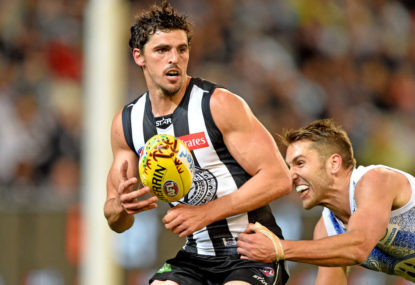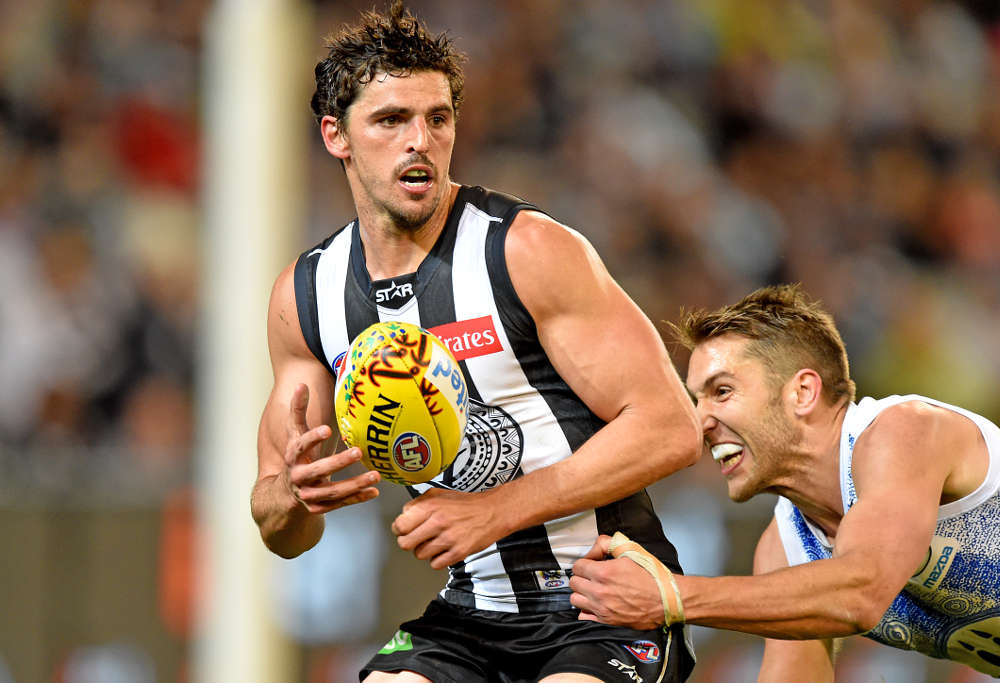LISTEN: Darcy Moore skilfully dodges question about whether the AFL should bring in extra time
Diplomatically answered, Darcy!

Collingwood Magpies captain Scott Pendlebury has dominated in his two early season starts, seemingly intent on dragging a winless Pies outfit out of the mire with his own two hands.
It seems wrong, but it’s true: Scott Pendlebury is well into the second half of his AFL playing career.
Drafted by Collingwood at pick five in 2005, Pendlebury is set to play his 250th game of football in Round 15 against the Hawks at the MCG.
His 11 year and two game career is studded with credentials: a premiership player (2010), a Norm Smith medallist (2010), an AFL Coaches’ Association award winner (2013), a five time Collingwood best and fairest winner (2011, then 2013 through 2016), and five time All Australian.
Collingwood’s captain since 2014, Pendlebury hasn’t won a Brownlow medal; the vagaries of the 3-2-1 system conspiring to keep Charlie out of his grasp. Now Sam Mitchell has one, Pendlebury sits second behind Geelong’s Joel Selwood as the active player with the most career Brownlow medal votes without a win.
Pendlebury is one of the most durable players in the competition. After playing six games in his debut season, Pendlebury has played in 229 of a possible 242 games. It’s not quite a Bryce Gibbs level of health and availability, but it is close.
After ascending to the highest peak, and enjoying the view from a lofty plateau for a year or two, Collingwood have steadily made their way down to the depths of mediocrity. Pendlebury has not.
The man Jay Croucher likes to call the lord of bullet time has continued to display a consistent excellence that few current players can match. Possibly no players.
The simplest way to display this is a chart. Below, I’ve plotted every AFL player that played at least 10 games in season 2016 against two criteria: average disposals per game and the percentage of disposals that result in giveaway (which is total clangers take total free kicks against – as I understand a clanger is unforced turnovers + free kicks against). The axis are set at the 90th percentile, meaning players who are in the top right hand quadrant are ranked in the top 10 per cent of players in the competition on both metrics. I’ve also inverted the horizontal axis, because the lower the turnover ratio the better.
Like the Nat Fyfe Quadrant and the Dangerzone before it, the Pendlebury Pedestal has very few members. One of them, as the name would imply, is Scott Pendlebury. Another, remarkably, is Melbourne’s Nathan Jones.

The data shows, generally speaking, that players who have high disposal averages tend to make more mistakes. It isn’t a strictly one to one relationship, but it is a relationship that does not hold for Pendlebury. Indeed, he has consistently delivered a giveaway ratio that would put him in the top five in the league in the 2016 year.
Despite continuously reprising his role as one of the most reliably outstanding players in the competition, Scott Pendlebury has not been voted into the All Australian team in the past two seasons. His last gig was in 2014, when Collingwood first dropped out of the finals series after eight straight seasons of participation.
The 2015 and 2016 snubs have come despite Pendlebury’s raw numbers being almost indistinguishable from 2014, and 2013, and 2012, and 2011, and 2010. Take a look for yourself.
| Year | Disposals | Goals | Tackles | I50s | Clearances | Contested Possessions | Goal Assists | Giveaway Ratio |
| 2006 | 13.1 | 0.4 | 2.8 | 1.1 | 1.8 | 4.1 | 0.1 | 10.2% |
| 2007 | 18.9 | 0.9 | 3.3 | 2.6 | 2.2 | 7.2 | 0.5 | 7.8% |
| 2008 | 22.5 | 0.5 | 3.4 | 2.4 | 3.1 | 8.0 | 0.8 | 4.0% |
| 2009 | 25.8 | 0.4 | 3.3 | 3.3 | 4.4 | 9.3 | 0.8 | 5.3% |
| 2010 | 26.6 | 0.7 | 5.5 | 3.6 | 3.7 | 10.8 | 0.7 | 5.1% |
| 2011 | 29.7 | 1.0 | 6.0 | 4.4 | 5.2 | 13.3 | 0.9 | 3.6% |
| 2012 | 29.5 | 0.5 | 5.5 | 3.9 | 6.4 | 14.1 | 0.7 | 6.4% |
| 2013 | 29.9 | 0.8 | 5.2 | 4.1 | 5.7 | 12.6 | 0.8 | 6.4% |
| 2014 | 28.4 | 0.6 | 5.5 | 3.4 | 5.3 | 13.0 | 0.7 | 6.9% |
| 2015 | 28.9 | 0.7 | 5.1 | 4.1 | 4.6 | 11.0 | 1.0 | 5.7% |
| 2016 | 28.6 | 0.5 | 5.6 | 4.0 | 4.6 | 12.6 | 0.7 | 5.9% |
| 2017 | 33.5 | 1.0 | 5.0 | 5.0 | 7.5 | 18.5 | 0.5 | 7.5% |
These days, Pendlebury’s name is rarely mentioned amongst the likes of Fyfe, Dangerfield, Lance Franklin, Joel Selwood, Dustin Martin, Sam Mitchell and other game breaking players in the league. Indeed, some quarters are beginning to question whether Adam Treloar has taken over the mantle as Collingwood’s best midfielder.
Are the league, the media, its fans, and the supposed opinion leaders that vote on key awards suffering a bout of Pendlebury fatigue? Has his consistent brilliance become a little, well, mundane?
Pendlebury’s start to 2017 suggest he has taken his recent snubbing, and fall down the subconscious pecking order of AFL talent, personally.

Simply, Pendlebury has started the 2017 AFL season in world boss mode. His play has been better than ever, winning the ball on the inside, helping to finish off on the outside, and executing plays most players can’t even cook up in their football brains.
Two plays from last round’s loss to Richmond were more in your face than the standard Pendlebury fair. In the spirit of the league’s supposed fascination with the handball, they were both the shorter of the disposal methods. Both occurred in the middle of the MCG, came in generally impossible situations, and resulted in goals which would have otherwise not materialised.
The first was a hospital handball receive from Steele Sidebottom, into a situation with two Richmond defenders, Ben Griffiths and Shaun Edwards, bearing down. A third, Dustin Martin, makes contact with Sidebottom but quickly switches to Pendlebury. A fourth man, Bachar Houli, is a few metres off the back of the play. In essence, Pendlebury is surrounded. He doesn’t care.
Scott Pendlebury stops time and space (@DownIsTheNewUp_ @RestingPlayers @RyanBuckland7 ) pic.twitter.com/3SPDYHlvkx
— Ethan (@ethan_meldrum) March 31, 2017
Pendlebury pump fakes, drawing Griffiths and stopping Edwards in his tracks. This allows Martin to take the step required to get in Pendlebury’s face. Within one tenth of a second, Pendlebury is able to reload and launch the release handball to Sidebottom. Pause the clip and look at the gravitational pull he creates.
Sidebottom takes possession at the very extreme of his reach, Pendlebury almost willing him to flick the ball swiftly on to a cruising Brodie Grundy who kicks a goal from 50 metres. I’m convinced very few players could have played chess in a three-on-one.
The second is in a breakaway play, with Pendlebury receiving the ball near the defensive end of the centre square. His strides are long and the epitome of balance. As he runs forward, three Richmond defenders bear down at what looks like 120 degree increments. The pump fake returns, before a millimetre perfect lofting handball launches from nowhere.
@DownIsTheNewUp_ @RestingPlayers @ethan_meldrum pic.twitter.com/xxtUyOVrO7
— Ryan Buckland (@RyanBuckland7) March 31, 2017
It lands in Tim Broomhead’s breadbasket; he releases a running Will Hoskin-Elliot, and six more points materialise.
Jesus reportedly turned water into wine. Pendlebury doesn’t need the water.
His early season counting stats are a marker of his influence. Pendlebury has averaged 33.5 disposals, 18.5 contested possessions, five tackles, five inside 50s and booted a goal in both hit outs. He’s been involved in eight of Collingwood’s scores per week, in both gregarious and covert ways.
Pendlebury looks to have bulked up meaningfully once more, and has spent much of his ground time roving packs and running on the ball. After reportedly spending much of 2016 carrying a rib injury, he looks in sparkling nick.
Collingwood’s season might have gotten off to a less-than-ideal start, but as Jay wrote earlier in the week, Pendlebury’s sunshine lights up the darkest of scenes.
The Pies are 0-2, and travel to Sydney this week to take on a winless Swans side. Like every week, Pendlebury will weave some of his unique craft into the tapestry of the game, powering the Collingwood midfield against a unit that he’s traditionally struggled against (Pendlebury averages 23 touches in his 17 games against Sydney, the lowest of any opponent).
Given his stellar start to the year, and the story he seems intent on writing for himself in 2017, a trademark big game looks in prospect.